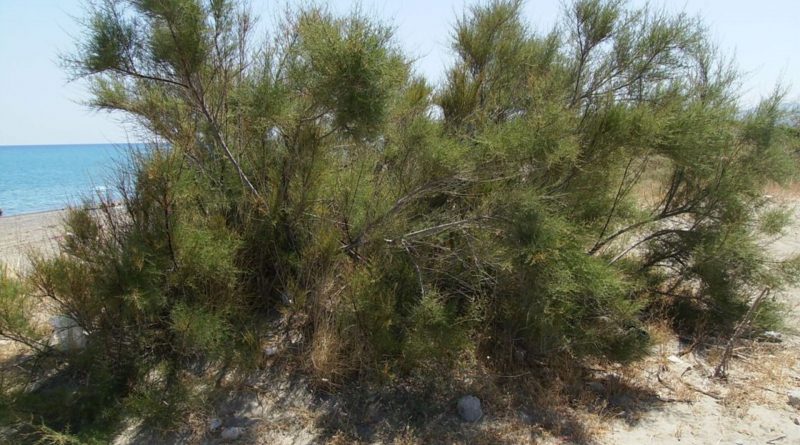Tamarix gallica
Tamarix gallica
The French tamarisk (Tamarix gallica L.) is a medium-sized tree or shrub belonging to the Tamaricaceae family. It is also known by the vulgar names of cypress, tamarisk, tamarisk and sea broom.
Systematics –
The systemic Tamerice belongs to the Eukaryota Domain, Kingdom Plantae, Tracheobionta Subarrange, Spermatophyta Superdivision, Magnoliophyta Division, Magnoliopsida Class, Order Caryophyllales, Family Tamaricaceae and therefore to the Genus Tamarix and to the T. Gallica Species.
Etymology –
The term Tamarix is derived from Támaris, river of Hiberia and assonant with the Arabic tamár; Palm tree; the specific Gallic epithet certainly derives from the Gauls, the present-day France.
Geographic Distribution and Habitat –
The French tamarisk grows mainly in coastal environments, on the river banks, always in loose, sandy or gravelly soils. It is a plant that tolerates saltiness and also grows in saline soils. It is found spontaneous in the coastal areas of the western Mediterranean, from sea level up to 800 meters above sea level.
Description –
The tamarisk looks like a shrub or a small woody tree, with a height ranging from 5 to a maximum of 9-10 meters, semi-evergreen. The Tamarix gallica has a short trunk erect, but more often curved, with a cinerine color and deep incisions. It has a bushy and irregular shape, green-gray glaucous, with long thin and flexible branches. It is characterized by brown-violet buds, very small alternate leaves, squamiform with acute apex, ovate-lanceolate, covering the branches; the flowers of Tamarix Gallica are numerous and very small, with a color ranging from whitish to rosé, gathered in terminal spikes; the plant blooms between May and July. The flowers are presented with a corolla of 5 yellowish or pink petals, with 5 protruding stamens; the pistil is with ovario supero and is surmounted by 3 threadlike styles. The fruit is a capsule enlarged at the base and thin at the apex, with a triangular base.
Cultivation –
The Tamarix gallica is also cultivated as an ornamental plant and loves bright and sunny places for many hours a day; even if he is not afraid of the cold, he bears the late frosts badly.
As said prefers dissolved and drained soils, they grow also in the absence of irrigation that can be administered only in the most juvenile period of the plant. despite being a very rustic plant of mature manure replanting it gives it greater vigor. Propagation can be by seed in spring or by woody cutting. For the ornamental plants the pruning serves to eliminate branches and dry twigs and shortening the long ones to the limit. From the health point of view, Tamarix gallica fears oidium, especially if the climate is excessively humid. Among the animal parasites it fears the attack of the Metcalfa and the larvae of the rodilegno that dig showy galleries in the trunk and on the branches.
Customs and Traditions –
The French tamarisk is an excellent plant for the reforestation of sandy and salty places, as a windbreak barrier, for the consolidation of dunes and therefore for all those marine areas where you need to start creating a plant cover. In the past it was used as forage as the cattle appreciated its salty flavor. Today it is often used as an ornamental tree in gardens, parks, avenues.
Characteristic of this plant, also observed on the seashore, is the “sweating” in the form of drops of clear and extremely salty liquid, which during the day and in the absence of wind (which would favor evaporation) falls to the ground.
From the medicinal point of view, Tamarix has an elective organotropism for the bone marrow. It stimulates the regular formation of platelets, red blood cells and white blood cells. It is recommended in case of viral platelet disorders (mumps, rubella, hepatitis, mononucleosis) or following haemorrhages.
Tamarisk promotes the absorption of all minerals such as calcium in the bones, magnesium, or silicon.
Tamarix gallica food supplement is used in all forms of anemia, in case of erythrocyte deficiency, iron and ferritin deficiency.
In herbal medicine it is used to rebalance the physiological functions and the storage capacity of the spleen.
Together with Ribes nigrum it helps to counteract the typical fatigue of the sequelae of mononucleosis.
Furthermore, the Tamerice bud extract is a safe natural remedy without contraindications. It can also be used safely by children.
Preparation Method –
There are no particular uses for food use while research is becoming more and more interested, as mentioned above, in the pharmacological field.
Tamarix gallica glycerine macerate can be associated with supplements that can support and facilitate its action in cases of anemia and demineralization.
in these cases there are specific preparations on the market that can be taken with water or herbal teas.
Guido Bissanti
Sources
– Wikipedia, the free encyclopedia.
– Treben M., 2000. Health from the Pharmacy of the Lord, Advice and experience with medicinal herbs, Ennsthaler Publisher
– Pignatti S., 1982. Flora of Italy, Edagricole, Bologna.
– Conti F., Abbate G., Alessandrini A., Blasi C. (edited by), 2005. An annotated checklist of the Italian vascular flora, Palombi Editore.
Warning: Pharmaceutical applications and alimurgical uses are indicated for informational purposes only and do not in any way represent a medical prescription; there is therefore no liability for their use for curative, aesthetic or food purposes.


